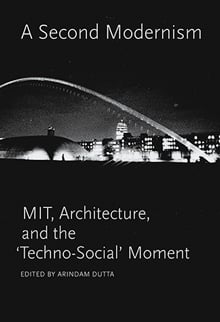World War II transformed MIT. Mainly, the wartime federal funding directed to the Institute expanded its basic research in the hard sciences. But MIT’s evolution into a research university also influenced the intellectual landscape of its architects.

Arindam Dutta, Editor
MIT Press, 2013, $65
This new “primacy of funded research” would move academic architects “towards a ‘problem-solving’ and relevance-seeking mentality, transforming the very sense of their discipline,” writes architectural historian Arindam Dutta in his introduction to a new book on MIT and modernist architecture.
The practice of design, for many MIT architects, now involved drawing upon the social sciences—from psychology to information science and systems theory—while developing new ideas. This approach set the Institute apart: “What had been posed elsewhere at the end of the war as a training of the intuition—in the imported, Bauhaus system—was at MIT transformed into a subject for ‘research,’” Dutta writes.
Dutta’s new book, A Second Modernism: MIT, Architecture, and the ‘Techno-Social’ Moment, features essays and interviews examining how MIT architectural scholars and practitioners pursued their modernist visions. They designed prefabricated buildings, developed early solar-powered structures, and worked on futuristic buildings with little-used construction materials such as plastic, as seen in the Monsanto House exhibit at Disneyland in the 1950s and 1960s.
The book makes clear that no unitary aesthetic guided MIT’s modernist architects. The best-known campus building designed by a faculty member at the time, Eduardo Catalano’s Stratton Student Center, is an austere Brutalist structure. Professor Pietro Belluschi designed the Pan Am building, a prominent 1960s Manhattan skyscraper (now the MetLife Building). But faculty member Maurice Smith’s designs (including a chaotic-looking wooden house outside Boston) were a reaction against such imposing visions.
The volume also examines seminal figures including painter and design theorist Gyorgy Kepes and urban planner Kevin Lynch, who studied the visual impact of cities on people. Some essays assess MIT’s famous modernist buildings, such as Eero Saarinen’s Kresge Auditorium and MIT Chapel; the book also features first-person accounts from people involved in the architecture program.
“It was important that the book have a variety of voices,” Dutta says. “In some ways it’s like reconstructing a kind of Rashomon-like narrative.”
Postwar architecture has not been the primary focus of Dutta’s career. His 2006 book The Bureaucracy of Beauty explores architecture and design in the British Empire, and his next book, Dutta says, will examine “economic liberalization and cultural politics in India.” But when editing A Second Modernism, he was eager to think locally, not just globally.
The book is “not a matter of praising or criticizing” MIT, he says, “but of trying to build a historical account of what went on, and the forces and dynamics at play.”
Recent Books from the MIT Community
Nuclear Strategy in the Modern Era: Regional Powers and International Conflict
By Vipin Narang, assistant professor of political science
Princeton University Press, 2014, $95
The Atlas of Economic Complexity: Mapping Paths to Prosperity
By Ricardo Hausmann and César A. Hidalgo, professor at the Media Lab
MIT Press, 2014, $50
Translating Euclid: Designing a Human-Centered Mathematics
By Gerry Stahl ’67
Morgan & Claypool, 2013, $50
The Tech Entrepreneur’s Survival Guide: How to Bootstrap Your Startup, Lead Through Tough Times, and Cash In for Success
By Bernd Schoner, PhD ’00
McGraw-Hill, 2014, $26
“Maxwell’s Demons Everywhere: Evolving Design as the Arrow of Time”
By Adrian Bejan ’71, SM ’72, PhD ’75
Published February 10, 2014, in Nature’s Scientific Reports
Piercing Time: Paris After Marville and Atget 1865–2012
By Peter Sramek ’73
University of Chicago Press, 2013, $64.50
How to Negotiate Your First Job: 8 Steps That Will Create Value for You and Your New Employer
By Paul F. Levy ’72, SB ’74, MCP ’74, and Farzana S. Mohamed ’99, MCP ’01, MEng ’01, SM ’01
Process Improvement, 2014, $9.95
Russian Case Morphology and the Syntactic Categories
By David Pesetsky, PhD ’83, professor of modern languages and linguistics
MIT Press, 2013, $30
Please submit titles of books and papers published in 2013 and 2014 to be considered for this column.
Contact MIT News
E-mail mitnews@technologyreview.com
Write MIT News, One Main Street, 13th Floor, Cambridge, MA 02142
Fax 617-475-8043
Keep Reading
Most Popular
Large language models can do jaw-dropping things. But nobody knows exactly why.
And that's a problem. Figuring it out is one of the biggest scientific puzzles of our time and a crucial step towards controlling more powerful future models.
The problem with plug-in hybrids? Their drivers.
Plug-in hybrids are often sold as a transition to EVs, but new data from Europe shows we’re still underestimating the emissions they produce.
Google DeepMind’s new generative model makes Super Mario–like games from scratch
Genie learns how to control games by watching hours and hours of video. It could help train next-gen robots too.
How scientists traced a mysterious covid case back to six toilets
When wastewater surveillance turns into a hunt for a single infected individual, the ethics get tricky.
Stay connected
Get the latest updates from
MIT Technology Review
Discover special offers, top stories, upcoming events, and more.